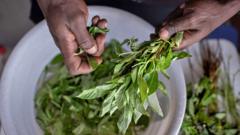In recent years, indigenous leafy vegetables in Kenya, often scorned as "weeds" and "poor man's food," are undergoing a renaissance, significantly climbing in popularity among consumers and chefs alike. At the bustling Skinners Restaurant in Gachie, a suburb of Nairobi, the widespread desire for "kienyeji"—local vegetable varieties—has surged, even as they are priced higher for their scarcity compared to more common imported greens like cabbage and kale. Kimani Ng'ang'a from the restaurant notes that "many people ask for kienyeji when they come here," highlighting a growing awareness of the health advantages of consuming these traditional crops.
This shift in culinary preferences reflects a broader trend toward sustainable eating habits, with health-conscious Kenyans recognizing the benefits of local, organically grown vegetables. Popular indigenous varieties, such as "managu" (African nightshade), boast an array of micronutrients exceeding even those found in common vegetables like sukumawiki, a staple referred to as "stretch the week" in Swahili. Horticulture expert Mary Abukutsa-Onyango asserts the nutritious superiority of these native plants, noting their potential to reinforce the immune system and promote overall health.
Over the last decade, production of indigenous greens has doubled, with local farmers producing around 300,000 tonnes the previous year alone. However, the recognition of traditional crops has evolved slowly; during the 1980s, Prof. Abukutsa-Onyango was taken aback by the dismissive terms used for these plants, which did not feature prominently in academic literature. Today, her efforts in promoting these vegetables are receiving international recognition, highlighted by UNESCO's acknowledgment of Kenya's project to document traditional foods, now encompassing 850 indigenous species.
Despite the progress in popularizing these forgotten crops, challenges remain. Imported varieties, particularly sukumawiki, are still favored by the majority of farmers, leading to a monopoly on crop production that inhibits the growth of indigenous alternatives. For instance, Francis Ngiri, who transitioned his farming operations to Kenya's Rift Valley to propagate organic native crops, has successfully expanded the variety of indigenous plants on his farm from 14 to 124 since 2016. His endeavors, however, bypass current government regulations that restrict seed swapping, which critics argue hinders efforts to preserve local agricultural biodiversity.
Wambui Wakahiu, an advocate for seed conservation, stresses that more than 35 traditional varieties have been lost to non-supportive policies prioritizing certified seeds from commercial sources. This has raised concerns over the potential extinction of invaluable indigenous crops if the focus remains solely on foreign varieties.
Despite legal limitations, the market demand for indigenous greens continues to grow, as vendors like Priscilla Njeri from the Wangige market observe a clear preference for local options. The public's appetite for kienyeji is strengthening amidst increased media advocacy promoting their health benefits, leading to significant changes in consumer habits. As the journey toward embracing indigenous crops faces legal and societal challenges, the culinary landscape in Kenya is evolving, allowing these once-forgotten vegetables to reclaim their rightful place on family tables.
This shift in culinary preferences reflects a broader trend toward sustainable eating habits, with health-conscious Kenyans recognizing the benefits of local, organically grown vegetables. Popular indigenous varieties, such as "managu" (African nightshade), boast an array of micronutrients exceeding even those found in common vegetables like sukumawiki, a staple referred to as "stretch the week" in Swahili. Horticulture expert Mary Abukutsa-Onyango asserts the nutritious superiority of these native plants, noting their potential to reinforce the immune system and promote overall health.
Over the last decade, production of indigenous greens has doubled, with local farmers producing around 300,000 tonnes the previous year alone. However, the recognition of traditional crops has evolved slowly; during the 1980s, Prof. Abukutsa-Onyango was taken aback by the dismissive terms used for these plants, which did not feature prominently in academic literature. Today, her efforts in promoting these vegetables are receiving international recognition, highlighted by UNESCO's acknowledgment of Kenya's project to document traditional foods, now encompassing 850 indigenous species.
Despite the progress in popularizing these forgotten crops, challenges remain. Imported varieties, particularly sukumawiki, are still favored by the majority of farmers, leading to a monopoly on crop production that inhibits the growth of indigenous alternatives. For instance, Francis Ngiri, who transitioned his farming operations to Kenya's Rift Valley to propagate organic native crops, has successfully expanded the variety of indigenous plants on his farm from 14 to 124 since 2016. His endeavors, however, bypass current government regulations that restrict seed swapping, which critics argue hinders efforts to preserve local agricultural biodiversity.
Wambui Wakahiu, an advocate for seed conservation, stresses that more than 35 traditional varieties have been lost to non-supportive policies prioritizing certified seeds from commercial sources. This has raised concerns over the potential extinction of invaluable indigenous crops if the focus remains solely on foreign varieties.
Despite legal limitations, the market demand for indigenous greens continues to grow, as vendors like Priscilla Njeri from the Wangige market observe a clear preference for local options. The public's appetite for kienyeji is strengthening amidst increased media advocacy promoting their health benefits, leading to significant changes in consumer habits. As the journey toward embracing indigenous crops faces legal and societal challenges, the culinary landscape in Kenya is evolving, allowing these once-forgotten vegetables to reclaim their rightful place on family tables.

















